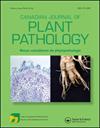Combined effects of Ascophyllum nodosum seaweed extract and biological control agents on Meloidogyne javanica in soybean
IF 1.5
4区 农林科学
Q3 PLANT SCIENCES
引用次数: 0
Abstract
Abstract This study aimed to investigate the efficacy of Ascophyllum nodosum extract, in combination or not with biocontrol agents, in the management of Meloidogyne javanica in soybean, assess treatment effects on soil biological activity, and determine the total phenolic content of the extract. The experiment was conducted according to a 5 × 2 factorial design, with three biocontrol agents (Bacillus methylotrophicus, Pochonia chlamydosporia, and Trichoderma harzianum), a chemical nematicide (abamectin, positive control), and an untreated (negative) control, each in the presence and absence of A. nodosum extract. Treatments included six replications. Nematode inoculation (2000 eggs + juveniles of M. javanica per plant) was performed at the time of sowing. Sixty days later, plants were evaluated for height, shoot weights, numbers of M. javanica eggs and J2 extracted from roots, and soil biological activity. Biological and chemical nematicide treatments were effective in reducing M. javanica multiplication. There was a synergic effect of A. nodosum extract on M. javanica multiplication for the treatments with A. nodosum + T. harzianum, A. nodosum + abamectin (Trial 1) and A. nodosum + P. chlamydosporia (Trial 2). B. methylotrophicus and T. harzianum treatments enhanced plant development and soil microbial biomass carbon. Higher values of soil basal respiration and metabolic quotient (qCO2) were observed in the A. nodosum + abamectin treatment. A. nodosum extracts at 75 g L−1 had a total phenolic content of 13 255 and 11 608 mg GAE 100−1 g in Trials 1 and 2, respectively.结节叶海藻提取物和生物防治剂对大豆根结线虫的联合作用
摘要本研究旨在研究结瘤叶提取物与生防剂联合或不联合对大豆中爪哇根结线虫的治理效果,评估处理对土壤生物活性的影响,并测定提取物的总酚含量。实验根据5×2析因设计进行,使用三种生物防治剂(甲基营养芽孢杆菌、厚垣孢子虫和哈茨木霉)、一种化学杀线虫剂(阿维菌素,阳性对照)和一种未经处理的(阴性)对照,每种制剂都存在和不存在结节曲霉提取物。治疗包括6次重复。在播种时进行线虫接种(每株2000个卵+鸦胆子幼虫)。60天后,对植物的高度、地上部重量、从根中提取的鸦胆子卵和J2的数量以及土壤生物活性进行评估。生物和化学杀线虫剂处理对减少爪哇M.javanica的繁殖是有效的。在用a.nodosum+T.harzianum、a.nodocum+abamectin(试验1)和a.nodorum+P.chlamydosporia(试验2)处理的情况下,a.nodonum提取物对爪哇M.javanica的增殖具有协同作用。B.methytrophicus和T.harzianum处理提高了植物发育和土壤微生物生物量碳。结瘤曲霉+阿维菌素处理的土壤基础呼吸和代谢商(qCO2)值较高。A.nodosum提取物在75 g L−1下的总酚含量为13 255和11 试验1和试验2中分别为608 mg GAE 100−1 g。
本文章由计算机程序翻译,如有差异,请以英文原文为准。
求助全文
约1分钟内获得全文
求助全文
来源期刊
CiteScore
4.50
自引率
5.00%
发文量
56
审稿时长
6-12 weeks
期刊介绍:
Canadian Journal of Plant Pathology is an international journal which publishes the results of scientific research and other information relevant to the discipline of plant pathology as review papers, research articles, notes and disease reports. Papers may be submitted in English or French and are subject to peer review. Research articles and notes include original research that contributes to the science of plant pathology or to the practice of plant pathology, including the diagnosis, estimation, prevention, and control of plant diseases. Notes are generally shorter in length and include more concise research results. Disease reports are brief, previously unpublished accounts of diseases occurring on a new host or geographic region. Review papers include mini-reviews, descriptions of emerging technologies, and full reviews on a topic of interest to readers, including symposium papers. These papers will be highlighted in each issue of the journal and require prior discussion with the Editor-in-Chief prior to submission.

 求助内容:
求助内容: 应助结果提醒方式:
应助结果提醒方式:


